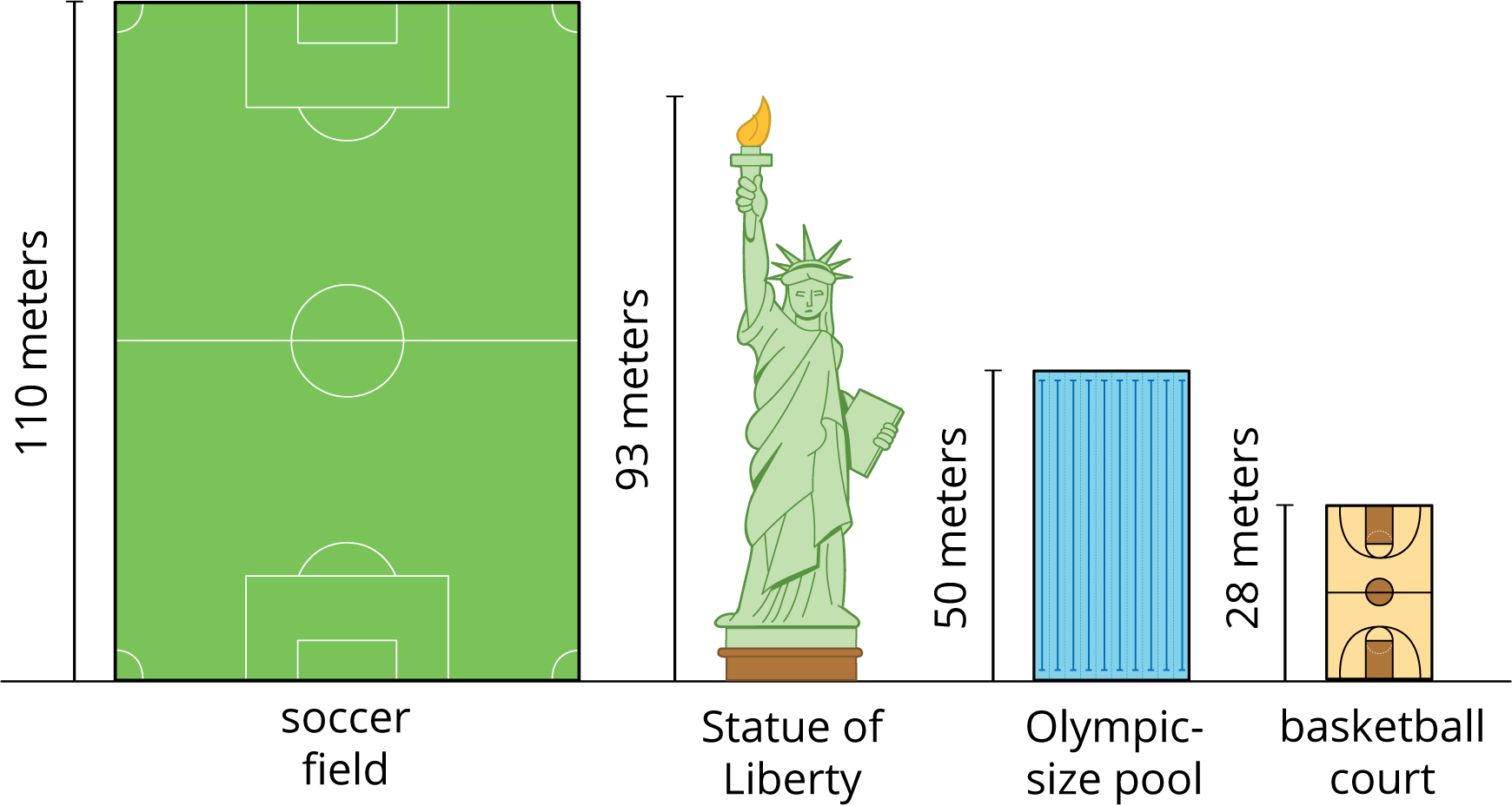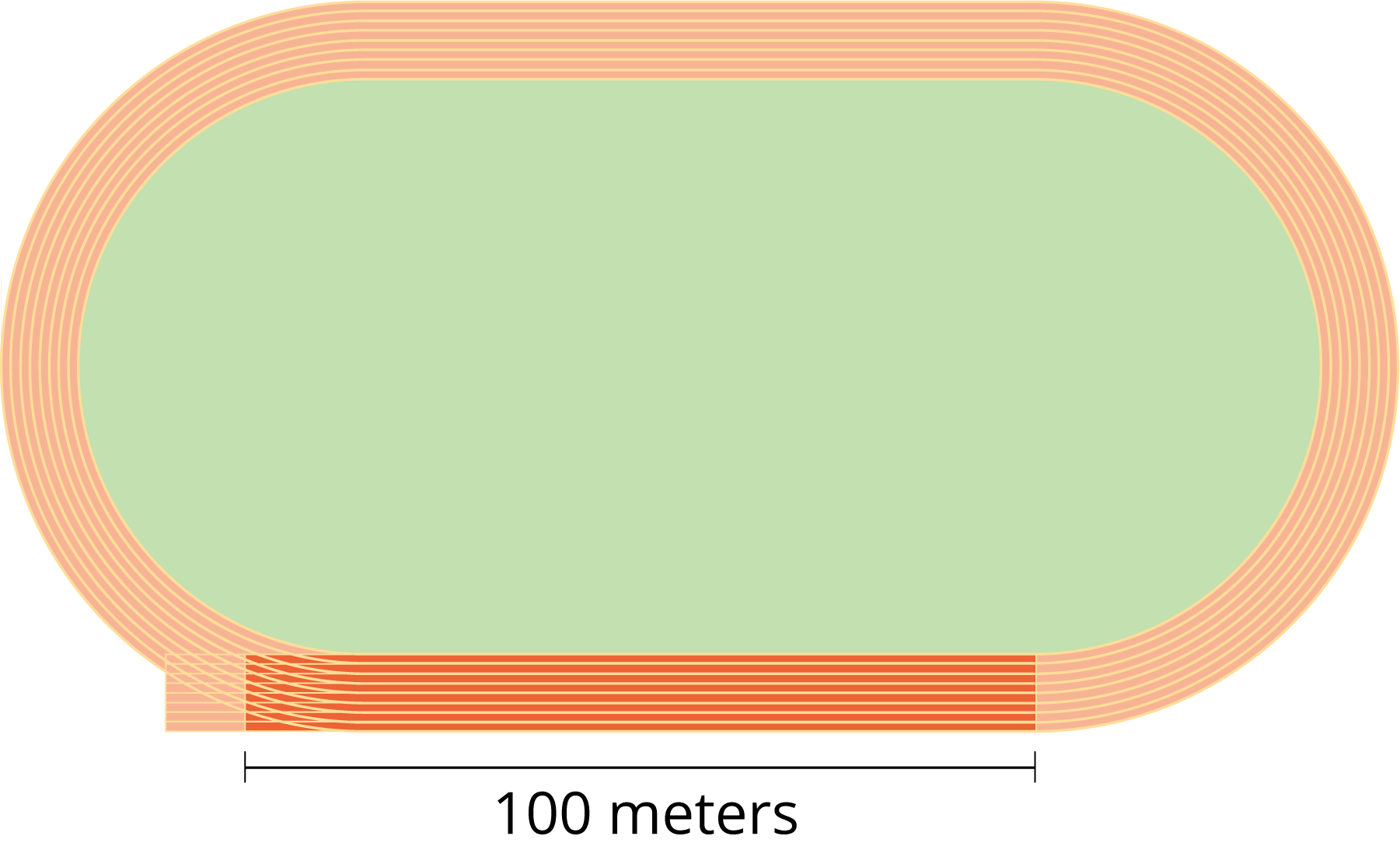Lesson 8
Meters and Kilometers
Warm-up: Number Talk: Times Hundreds and Thousands (10 minutes)
Narrative
This Number Talk encourages students to use what they know about multiples of 100, the relationship between hundreds and thousands, and properties of operations to mentally solve problems. The reasoning students do here will be helpful later in the lesson when students explore the relationship between kilometers and meters and convert measurements from the former to the latter.
Launch
- Display one expression.
- “Give me a signal when you have an answer and can explain how you got it.”
- 1 minute: quiet think time
Activity
- Record answers and strategy.
- Keep expressions and work displayed.
- Repeat with each expression.
Student Facing
Find the value of each expression mentally.
-
\(3 \times 100\)
-
\(40 \times 100\)
-
\(43 \times 100\)
-
\(43 \times 1,\!000\)
Student Response
For access, consult one of our IM Certified Partners.
Activity Synthesis
- “How does knowing \(43 \times 100\) help you find \(43 \times 1,\!000\)?” (1,000 is 10 times 100, so if we know \(43 \times 100\), we can multiply that by 10 to find \(43 \times 1,\!000\).)
Activity 1: How Long is One Kilometer? (20 minutes)
Narrative
The purpose of this activity is to build students’ intuition for 1 kilometer. Previously, students used centimeter grid paper and counted 100 units to build a length of 1 meter. Since building a kilometer is impractical, here students relate 1 kilometer to the length of other objects that may be more familiar. For instance, if an Olympic-size pool is 50 meters long, the length of 2 pools is 100 meters and the length of 20 pools is 1,000 meters or 1 kilometer.
The blackline master shows copies of a few objects: a soccer field, the Statue of Liberty, an Olympic-size pool, or a basketball court. Students work with their group to cut out these images and use the copies of each object to reason about the length of 1 kilometer.
Here are the images on the blackline master for reference:

Required Materials
Launch
- Groups of 4
- “How long do you think 10 meters is?”
- Consider asking students to use the meter strips to illustrate 10 meters.
- “How long is 100 meters? How many meter-long strips do we need to make 100 meters?” (100 of the meter-long strips, or 10 of the 10-meter-long strips)
Activity
- “Now we will work with kilometers. Read the first problem and solve it on your own.”
- 2 minutes: independent work time
- Invite students to share their responses and reasoning.
- Highlight that if we take 10 of the 100-meter sections of the track and lay them end to end in a straight line, the total length would represent 1,000 meters or 1 kilometer.
- Give each group a pair of scissors and a copy of the blackline master.
- “You will now use the length or height of some other objects to represent 1 kilometer: a soccer field, the Statue of Liberty, an Olympic-size pool, and a basketball court.”
- “Work with your group to complete the rest of the activity.”
- “Each group member should choose a different object and think about how many of them are needed to represent exactly or approximately 1 kilometer.”
- “If you don’t have enough copies to reach 1 kilometer, think about how many more you’ll need to represent it.”
- 10–12 minutes: group work time
Student Facing
There are 1,000 meters in 1 kilometer.
-
The darkly shaded section of the track is the length of a 100-meter race. How many 100-meter races does it take to travel 1 kilometer?

-
Your teacher will give you images of something with a length or height measured in meters.
About how many of the items given to you are needed to make 1 kilometer? Explain or show how you know.
-
Work with your group to write a number in the blank so that each statement is true.
-
One kilometer is the length of (about, exactly) __________ soccer fields.
-
One kilometer is the length of (about, exactly) __________ Statues of Liberty.
-
One kilometer is the length of (about, exactly) __________ Olympic-size swimming pools.
-
One kilometer is the length of (about, exactly) __________ basketball courts.
-
- Estimate where you might end up if you travel 1 kilometer from your school’s front door.
Student Response
For access, consult one of our IM Certified Partners.
Activity Synthesis
- Select students to share their work on how the four objects compare to 1 kilometer.
- For each response, ask: “How did you know how many of that object it would take to make a length of 1 kilometer?” (Sample responses for the soccer field:
- I added 110 repeatedly until it reached 1,000.
- I know that 5 soccer fields make 550, and thought about how many of that length would make 1,000.
- I tried multiplying 110 feet by different numbers to reach 1,000.
- I thought about how many 110s would go into 1,000.)
- Invite students to share their responses to the last problem.
- Consider giving or showing students a map showing one or more points that are 100 meters from school and asking them to identify a place that is 1 kilometer away from school.
- Emphasize that 1 kilometer is 1,000 times as long as 1 meter. If we use 1 meter as a unit of measurement, we’ll need 1,000 of it to make 1 kilometer. Explain that “kilo” means a thousand.
Activity 2: Meters and Kilometers (15 minutes)
Narrative
The purpose of this activity is for students to convert measurements from kilometers into meters and reason the other way around. When the given measurement is a whole number of kilometers, students are likely to multiply the whole number by 1,000 to find its equivalent in meters. For \(\frac{1}{2}\) kilometer, they are likely to reason that half of 1,000 is 500, or that 1,000 divided by 2 is 500. Students are not expected to reason multiplicatively or to know that \(\frac{1}{2} \times 1,\!000\) is 500. The lesson synthesis focuses on discussing Andre's reasoning from the task.
Advances: Representing, Conversing
Supports accessibility for: Conceptual Processing, Language, Organization
Launch
- Groups of 2
- Display the table for all to see.
- “What do you notice? What do you wonder?”
- 30 seconds: quiet think time
- 30 seconds: partner discussion
- Students may have noticed and wondered about the “km” and “m” in the table. Clarify that these are abbreviations for kilometers and meters.
Activity
- 6–7 minutes: independent work time
- 2–3 minutes: partner discussion
- Monitor for the different ways students reason about 27 kilometers. For instance, they may:
- count by 1,000 27 times
- reason that 10 groups of 1,000 make 10,000, 20 groups make 20,000, and 7 more groups make 7,000
- use the previous values in the table: reasoning that \(27 = 12 + 10 + 5\) and adding the corresponding values in meters (\(12,\!000 + 10,\!000 + 5,\!000\))
- multiply 27 by 1,000
Student Facing
- Complete the table with the missing lengths in meters or kilometers.
kilometers (km) meters (m) \(\frac{1}{2}\) \(\phantom{000000000000}\) 1 1,000 5 6,000 \(8\frac{1}{2}\) 10 12,000 27 - Andre says 100 meters is longer than 10 kilometers. Do you agree or disagree? Explain or show your reasoning.
-
Which is greater? Be prepared to explain how you know.
-
2,000 meters or 3 kilometers
-
500 meters or 1 kilometer
-
14 kilometers or 14,000 meters
-
8 kilometers or 80,000 meters
-
Student Response
For access, consult one of our IM Certified Partners.
Advancing Student Thinking
Activity Synthesis
- Display the table.
- Invite selected students to share their reasoning on how they converted each whole-number measurement. Start with students who reasoned by counting and end with those who reason multiplicatively.
- Discuss how students found the number of meters in \(\frac{1}{2}\) and \(8\frac{1}{2}\) kilometers. Record their reasoning.
Lesson Synthesis
Lesson Synthesis
“Today we learned about the relationship between meters and kilometers.”
“Did you agree with Andre that 100 meters is longer than 10 kilometers? How did you know whether what he said was true?” (No, because a kilometer is 1,000 meters, which is already longer than 100 meters)
“Why might Andre have believed this was true?” (He compared the numbers 100 and 10 and saw that 100 was larger.)
Highlight explanations that made it clear that we cannot simply compare the number measurements without considering the units in which they were measured.
Cool-down: How Far Away from School? (5 minutes)
Cool-Down
For access, consult one of our IM Certified Partners.